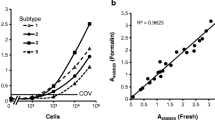Abstract
In order to determine the comparative sensitivity of two methods of detecting Blastocystis hominis and to investigate the seasonality of infection with this enteric protozoan parasite, the present study was conducted. In each of two 3-month periods representing winter, spring (February–April) and summer (July–September), 500 routine stool submissions were examined for B. hominis using microscopy following either formol-ether concentration or in vitro culture using Jones’ medium. The organism was detected in 39 of the 1,000 samples investigated using the in vitro culture technique and in none of the samples using the formol-ether concentration technique. In 82% of the B. hominis-positive samples, no concurrent bacterial or parasitic pathogens were found, and diarrhoea was the most commonly recorded symptom among patients. Infection was more prevalent in summer than in winter/spring, occurring primarily in the 71–80-year age group. Cysts were detected in 20.5% of positive samples, but only following Ficoll-Paque concentration of formol-ether concentrates. Cyst excretion was more prevalent in summer than in winter/spring.
Similar content being viewed by others
References
Ashford RW, Atkinson EA (1992) Epidemiology of Blastocystis hominis infection in Papua New Guinea: age prevalence and associations with other parasites. Ann Trop Med Parasitol 86:129–136
Rajah S, Suresh K, Vennila GD, Khairul Anuar A, Saminathan R (1997) Small forms of Blastocystis hominis. J Int Med Res 1:93–96
Zaki M, Daoud AS, Pugh RNH, Al-Ali F, Al-Mutairi G, Al-Saleh Q (1991) Clinical reports of Blastocystis hominis in children. J Trop Med Public Health 25:792–793
Vennila GD, Suresh K, Rajah Salim H, Khairul Anuar A, Kudva M, Saminathan S, Ramakrishnan K (1999) Irregular shedding of Blastocystis hominis. Parasitol Res 85:162–164
Nassir E, Awad J, Abel AB, Khoury J, Shay M, Lejbkowicz F (2004) Blastocystis hominis as a cause of hypoalbuminemia and anasarca. Eur J Clin Microbiol Infect Dis 23: DOI 10.1007/s10096-004-1122-8
Stenzel DJ, Boreham PFL (1996) Blastocystis hominis revisited. Clin Microbiol Rev 9:563–584
Tan KS, Singh M, Yap EH (2002) Recent advances in Blastocystis hominis research: hot spots in terra incognita. Int J Parasitol 32:789–804
Stenzel DJ, Boreham PFL (1991) A cyst-like stage of Blastocystis hominis. Int J Parasitol 21:613–615
Zierdt CH, Tan HK (1976) Ultrastructure and light microscope appearance of Blastocystis hominis in a patient with enteric disease. Z Parasitenkd 50:277–283
Stenzel DJ, Boreham PFL, McDougall R (1991) Ultrastructure of Blastocystis hominis in human stool samples. Int J Parasitol 21:807–812
Zaman V, Khan KZ (1994) A comparison of direct microscopy with culture for the diagnosis of Blastocystis hominis. Southeast Asian J Trop Med Public Health 25:792–793
Suresh K, Khairul Anuar A, Saminathan T, Ng KP, Init I (1997) In vitro culture technique: a better diagnostic tool for Blastocystis hominis. J Int Med Res 1:5–7
Allen AVH, Ridley DS (1970) Further observations on the formol-ether concentration technique for faecal parasites. J Clin Pathol 23:545–546
Zaman V (1994) Morphology of the cysts of Blastocystis hominis. Southeast Asian J Trop Med Public Health 25:790–791
Boreham PFL, Upcroft J, Dunn LA (1992) Protein and DNA evidence for two demes of Blastocystis hominis from humans. Int J Parasitol 22:49–53
Doyle PW, Helgason MM, Mathias RG, Proctor EM (1990) Epidemiology and pathogenicity of Blastocystis hominis. J Clin Microbiol 28:116–121
Clark GC (1997) Extensive genetic diversity in Blastocystis hominis. Mol Biochem Parasitol 87:79–83
Yoshikawa H, Abe N, Iwasawa M, Kitano S, Nagano I, Wu Z, Takahashi Y (2000) Genomic analysis of Blastocystis hominis strains isolated from two long term health care facilities. J Clin Microbiol 38:1324–1330
Suresh K, Smith HV, Kusel J (2000) Blastocystis hominis: isolate differences. Trans R Soc Trop Med Hyg 94:618
Acknowledgement
We thank the Association of Commonwealth Universities for a Commonwealth Scholarship awarded to SK (MYCF-1999-66).
Author information
Authors and Affiliations
Corresponding author
Rights and permissions
About this article
Cite this article
Suresh, K., Smith, H. Comparison of methods for detecting Blastocystis hominis . Eur J Clin Microbiol Infect Dis 23, 509–511 (2004). https://doi.org/10.1007/s10096-004-1123-7
Published:
Issue Date:
DOI: https://doi.org/10.1007/s10096-004-1123-7




